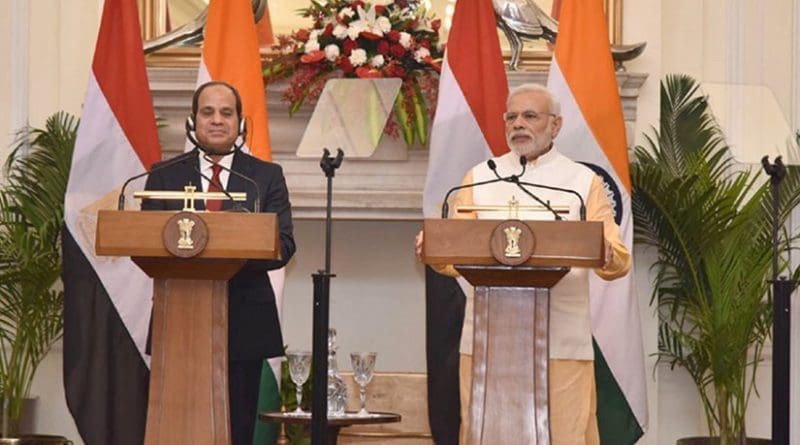Renewing Historical Ties between Egypt And India – Analysis
By Observer Research Foundation
By Kabir Taneja
Indian External Affairs Minister S Jaishankar’s visit to Egypt comes on the back of a steady increase in bilateral relations between New Delhi and Cairo after a long era of being in limbo. This was a first visit to Egypt by an Indian external affairs minister in seven years, however, this time it was underscored by joint-military exercises leading into top level political engagement.
Through July and August, the Indian Air Force (IAF) and the Egyptian Air Force (EAF) conducted various exercises at the Egyptian Fighter Weapons School, not far from the capital city. The composition of both the air forces is ironically similar, reflective of a significant period of history where both states were the founding members of the Non-Aligned Movement (NAM), under the leadership of India’s first Prime Minister, Jawaharlal Nehru, and Egypt’s second President, Gamal Abdel Nasser.
Both the IAF and EAF’s fighter fleets comprise a hodgepodge of imports, ranging from a variety of suppliers such as Russia, France, the United States, the United Kingdom, amongst others. Much like Delhi, Cairo—despite its contentious but close relations with the West—purchased 46 MiG-29 fighter jets from Moscow in 2015. This was to diversify its defence portfolio, and to send a signal to Washington, which had, over the years, balked on selling the country its preferred F-15 aircraft on the back of the former’s checkered human rights record. Egypt also had a further order of Russia’s premier Sukhoi 35 jets in place, however, geopolitical considerations ended the deal as Moscow’s relations with the West spiraled even before the current Ukraine war (the Sukhoi 35s in question now may end up with Iran). This level of import reliance was not always the case as, in the 1960s, both Cairo and New Delhi had embarked on localised programs to build homegrown fighter aircraft. The Indians had the HAL Marut, and the Egyptians, the Helwan HA-300. India looked to fund the development of the HA-300s engines, however, the program ran into turbulence due to, amongst other things, its European heritage, with a German designer and the British manufactured Bristol Siddley Orpheus engine that both the Marut and HA-300 used.
This era could be seen as the heyday of India-Egypt ties, lasting up until the 1980s. Since then, regional and domestic agendas between the two states have differed. Nonetheless, it could be argued that the COVID-19 pandemic, and the devastation it caused across the world, also acted as a catalyst to bring many bilateral relationshipsout of deep freeze as ‘vaccine diplomacy’ saw tribalism take root in the international order, with the West often hoarding medicines and countries of the Global South being left far behind in global vaccine equity. During the worst phase of India’s Delta wave in 2021, Egypt was one of the countries that sent medical oxygen supplies.
The revival of relations today is based on multiple geopolitical events. First, Egypt is in economic flux and requires an urgent infusion of capital to avoid any long-term economic distress. Having already seen through the Arab Spring, which was backed by people’s anger against economic destitution, cronyism and corruption, President Abdel Fattah El Sisi does not want another Tahrir Square in the country (more so that it led to a pro-Muslim Brotherhood government to take charge). His comment to Jaishankar, that a US $7 billion trade turnover between the two countries was not enough, highlights a sense of urgency in Cairo to course correct its current economic trajectory. Russia’s war on Ukraine and the commodity crunch that followed, specifically in the agriculture sector, saw a scramble to find substitutes to critical wheat imports. As India offered its produce as a viable alternative with an unnecessarily self-aggrandising tone, New Delhi banned export of wheat and rice soon after to protect domestic markets from potential supply crunch and inflation.
From India’s point of view, an outreach to Egypt is part of its larger construct of a security architecture in West Asia, particularly the Gulf, spearheaded by New Delhi’s excellent relations with the UAE, arguably the most powerful leader in the region today. Keeping in mind the Indian diaspora, trade and energy security coupled with the possibility of receding American interests, increasing Chinese interests, and intra-regional geopolitical friction, India has significantly increased its defence engagements with a geography where political structures value both the utility and posturing of flexing military might, and by association, power and intent. Operation Sankalp, which saw the Indian Navy escort oil tankers through the Strait of Hormuz as tensions between Saudi Arabia and Iran escalated, was a good example of India’s mandate in the region moving up from anti-piracy operations to overt protection of national assets and interests. With energy security set to become even more precarious over the next few years, India’s naval and aerial military engagements through the mechanism of joint exercises should also see an uptick. While other interests such as the Suez Canal are also critical for India as part of international trade systems, it is energy security that will dictate the priority of New Delhi’s limited defence assets considering the requirements on its immediate borders.
Finally, India-Egypt ties in their current stage will require time and honing to lead to more concrete strategic posture. The opening with defence exercises is also a good platform to further develop access to fulfil Egypt’s defence requirements. While the entire saga of India wanting to sell its HAL Tejas jets to Egypt was an over-ambitious and unrealistic endeavour, promoting defence along with agriculture, Information Technology, amongst others as areas of cooperation can benefit Cairo as it looks to diversify its economic footprint.

